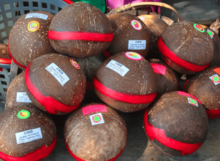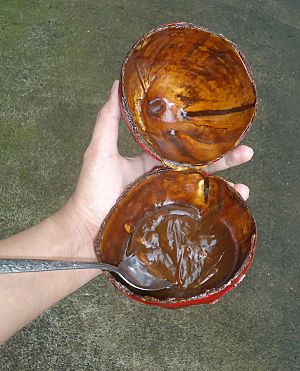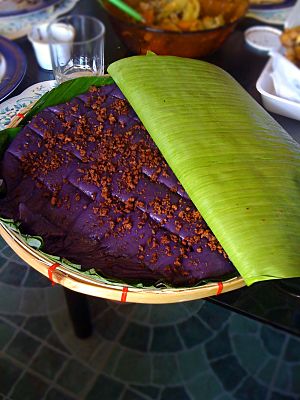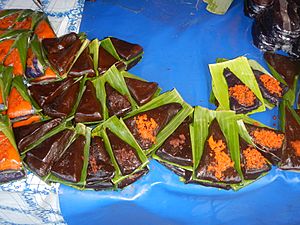Kalamay facts for kids

Kalamay from the province of Bohol packaged inside empty coconut shells. It is the famous delicacy from Bohol Province particularly in the town of Jagna.
|
|
| Alternative names | Calamay |
|---|---|
| Course | Dessert |
| Place of origin | Philippines |
| Region or state | Visayas, Luzon |
| Serving temperature | Hot, room temperature, cold |
| Main ingredients | Coconut milk, glutinous rice, brown sugar |
| Variations | Biko |

Kalamay (sometimes spelled Calamay) is a super sticky and sweet treat from the Philippines. Its name means "sugar." It's made from coconut milk, brown sugar, and special ground glutinous rice. Sometimes, people add flavors like margarine, peanut butter, or vanilla. You can eat Kalamay by itself, or use it to sweeten other Filipino desserts and drinks. It is similar to a Chamorro dessert called Kalamai.
Contents
How Kalamay is Made
Making Kalamay starts with coconut milk. First, fresh coconuts are grated, and their milk is squeezed out twice.
Mixing the Ingredients
The first batch of coconut milk is mixed with glutinous rice. This mixture is then ground into a smooth paste. Meanwhile, brown sugar is added to the second batch of coconut milk. This sweet coconut milk is boiled for many hours. This boiling process creates a thick, caramel-like sauce called latík.
Cooking the Kalamay
Next, the ground rice and coconut milk paste is poured into the hot latík. The mixture is stirred constantly until it becomes very thick and sticky. You can serve Kalamay warm or at room temperature. If you want it less runny and easier to eat, it's often served chilled.
How People Enjoy Kalamay
Kalamay is a popular pasalubong. This is a Filipino tradition where people bring home gifts from their travels.
Eating Kalamay
Often, people eat Kalamay straight from its packaging. It's also used to sweeten many traditional Filipino dishes. For example, it's added to suman and bukayo. You can even stir it into drinks like coffee, milk, or hot chocolate.
Similar Dishes
Some dishes, like biko and sinukmani, are very similar to Kalamay. They also use glutinous rice. The main difference is that for these dishes, the rice is cooked whole, not ground into a paste. Then, it's covered with latík. In some parts of the Northern Philippines, these dishes are also called kalamay. The very sticky kind is then called kalamay-hati.
The latík from Kalamay can also be used with other desserts. For instance, it's great with dishes made from cassava. There's also a similar sticky dish called matamis sa bao. However, this one doesn't use rice.
Different Kinds of Kalamay

There are many different types of Kalamay. They can be divided into two main groups. One is a syrupy kind, often used with other dishes. The other is a gummy, chewy kind, which is usually eaten by itself. This chewy type is often more expensive.
Regional Kalamay Varieties
- Antipolo kalamay (also called kalamay perya) – This is the Tagalog version of Kalamay. It's a special treat from Antipolo. It's usually served as a flat disk on banana leaves. It's topped with small curds of latik. This kind has a denser, chewier texture.
- Bohol kalamay – Kalamay from the island of Bohol can be very sweet or mildly sweet. It's special because it's sold inside halved coconut shells. These shells are sealed with red crepe paper. This packaging is known as kalamay-hati, meaning 'Half kalamay'. A famous type is "Calamay sa Jagna," from the town of Jagna. A priest named Rev. Fr. Mariano Gutierrez taught people how to make it.
- Baguio Kalamay – This type of Kalamay comes from Baguio, Philippines. It's also known as Sundot Kulangot (meaning 'Picked Booger') because of its texture. It's sweetened with molasses, which gives it a darker color. It's uniquely packed into small, halved pitogo (a type of palm) shells. These are also sealed with red crepe paper, similar to the Bohol Kalamay. They are sold in bundles, tied together with string inside split bamboo.
- Iloilo kalamay – This Kalamay (also called kalamay-hati) is from Iloilo and Negros. It's thicker than other types of Kalamay. The town of San Enrique even has a Kalamay Festival!
- Candon kalamay – This Kalamay is from Candon City, Ilocos Sur. It used to be wrapped in banana leaves or coconut shells. Today, it's often sold in plastic containers. Candon City also celebrates a Kalamay Festival.
- Nilubyan or iniruban – This Kalamay is made from pounded green rice. It comes from Camiling, Tarlac in the Northern Philippines.
- Mindoro kalamay – A version of Kalamay from the island of Mindoro. It often has grated coconut and is flavored with peanut butter or vanilla.
- Indang kalamay (also called calamay buna) – This sweet treat is well-known in Indang Cavite. It's made from sticky pulverized rice called malagkit. This is mixed with coconut milk and panutsa (a native type of jaggery or unrefined sugar).
Kalamay with Special Ingredients
Like other traditional kakanin (rice cakes), Kalamay also has versions based on what's added to it:
- Kalamay gabi – This Kalamay is made with taro (called gabi). It's usually milky white.
- Kalamay na pinpipig (also known as kalamay na duman or kalamay pandan) – This Kalamay is flavored with pandan leaf extracts. It's topped with toasted and pounded young rice grains (called pinipig or duman). It has a bright green color.
- Kalamay ube – This Kalamay is made with ube (purple yam). It has a beautiful lavender or purple color. It looks a bit like ube halaya, but it has a smoother texture.
The Origin of the Word Kalamay
In many Visayan languages (especially Hiligaynon), the word Kalamay means 'sugar'. This sugar is extracted from sugarcane. In modern Cebuano dialects, the word is often shortened to kamay. In the Waray language, Kalamay refers to a hardened cake of molasses. This molasses is used to sweeten many cooked desserts. People have been making it since the Spanish arrived in the Philippines.
Desserts Similar to Kalamay
A dessert similar to Kalamay is dodol. You can find dodol in Indonesia, Malaysia, Brunei, Singapore, and some parts of the Philippines. It uses similar basic ingredients and is made in a similar way. However, dodol is a solid candy, unlike the softer Kalamay. Kalamay also looks a bit like the Chinese nian gao (known as tikoy in the Philippines), but they are not related.
See also
 In Spanish: Kalamay para niños
In Spanish: Kalamay para niños


